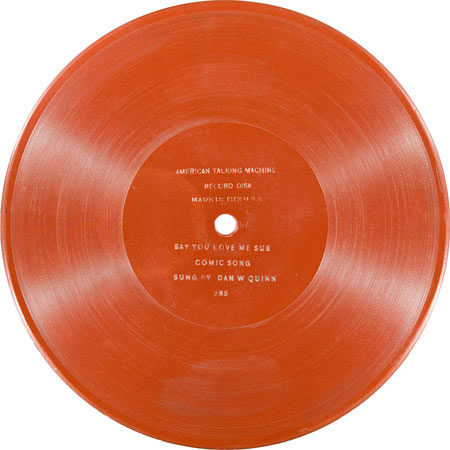In a previous post, we noted that Dan W. Quinn made a few duets ca. 1895 with Minnie Emmett for the United States Phonograph Company. This seems to be a fact not widely appreciated. Has anybody out there got one?
The U.S. Phono. Co. catalog says the following:
We have here two well-blended voices, producing a charming effect on the Phonograph. The work is a new and an original departure, and the duets are well adapted for general purposes. Very musical and showy, brilliant and firm in tone. Sure to be popular, both from the nature of the subjects and the reputation of the artists.
Priced at $1.50 each, the titles were “Gobble Song” (from La Mascotte), “Reuben and Cynthia” (from A Trip to Chinatown), “He’ll Love You Bye and Bye,” and “The Spider and the Fly (with Buzzing of Flies, Mewing of Cats, and Cat Duet)” (from Isle of Champagne). Emmett also did a solo with Mr. Maxwell, “Back to Our Mountains” (from Il Trovatore).
There was quite a buzz about Minnie Emmett in the industry of the mid- to late-1890s. Before she came along, no really effective records of the female voice had been made allegedly. The same U.S. Phono. Co. catalog says this of Ms. Emmett:
SOPRANO SOLOS BY MISS EMMETT.
ONLY SUCCESSFUL RECORDS OF THE FEMALE VOICE EVER TAKEN.
After a series of experiments extending over several years of record making, we can now offer to the public what we believe to be the first true records of a high soprano voice. No squeak, no blast, but natural, clear and human. Miss Emmett has a round, sweet voice, sympathetic, and under perfect control. Her records would sell on their merits, even if they did not represent a new achievement in our art. They are made one at a time.
She made “Sweet Marie,” “Somebody Loves Me,” “Little Wooden Shoes,” and “They Are the Best Friends of All.” A supplement, also ca. 1895, listed these and four others: “When You Know the Girl You Love, Loves You,” “Pretty Maggie Mooney,” “I Don’t Want to Play in Your Yard,” and “Rosie, Sweet Rosabel”—price, $2.00 each. Ouch.

Minnie Emmett (The Courier, April 22, 1904)
If you like the sound of a serious singer doing popular songs, then you’ll definitely like Emmett. If, however, you prefer your comediennes to sing in a more rough-and-ready way, stick to Ada Jones or Elida Morris. But a web search for Minnie Emmett shows a good amount of interest in her, so it’s necessary to make a few observations.
Continue reading →







